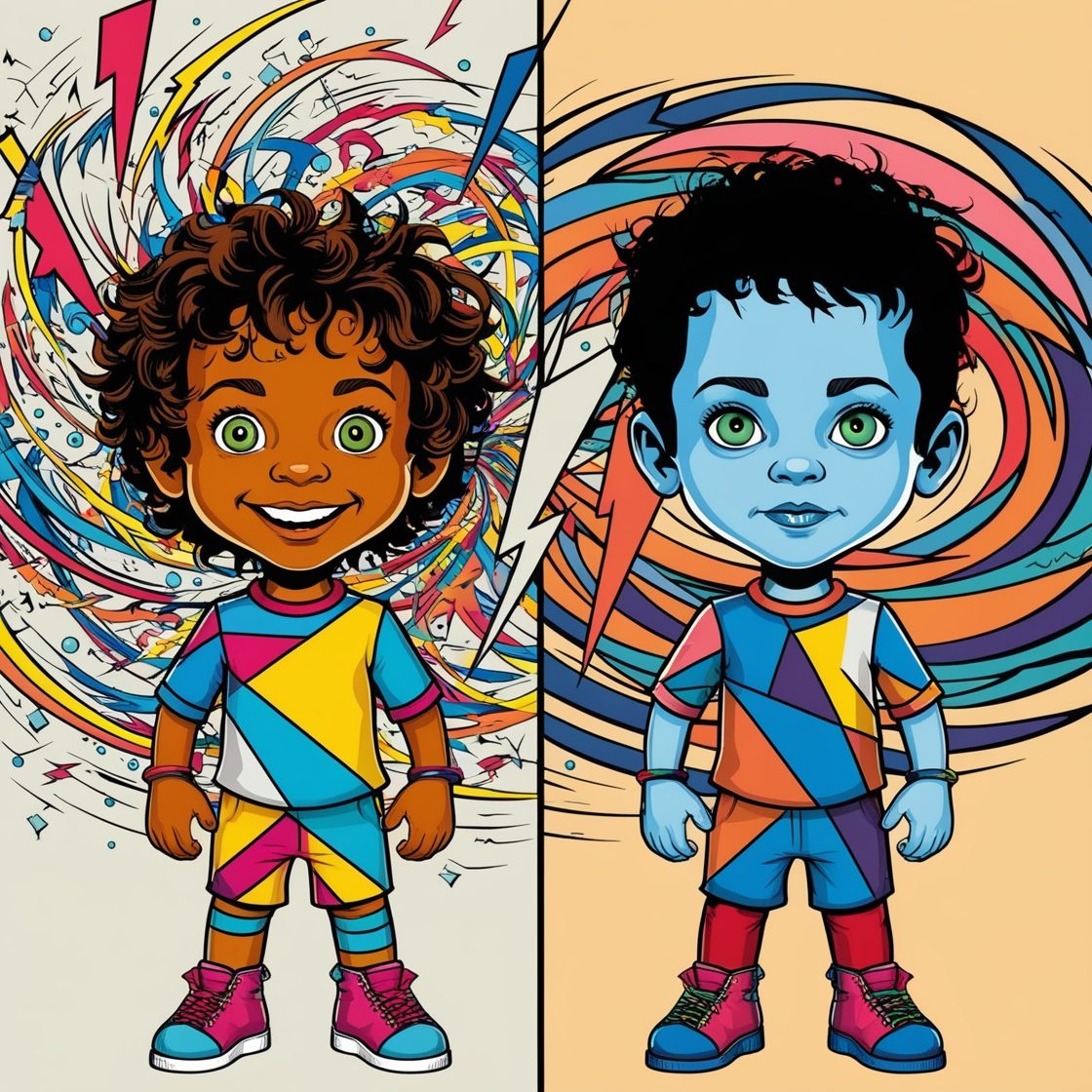Get your free Book Here

Understanding Your Child’s Mood Swings: Signs of Bipolar Disorder You Shouldn’t Ignore
As a life coach, I often hear about the challenges that parents face when it comes to understanding their children. One of the most perplexing issues is the occurrence of mood swings—something that every child experiences in varying degrees. However, it’s crucial to recognize when these emotional ups and downs might signify something more serious, such as bipolar disorder. In this blog post, we’ll explore the symptoms, causes, and management strategies around children’s mood swings, helping you to differentiate typical behavior from potential warning signs of bipolar disorder.
Chapter 1: The Nature of Mood Swings
Children’s moods can fluctuate for numerous reasons—hormonal changes, environmental influences, or simply the stresses associated with day-to-day life. Understanding the nature of mood swings is essential in discerning whether these fluctuations are part of a usual developmental phase or symptoms of a more significant emotional challenge.
When considering mood swings in children, keep the following factors in mind:
-
- Duration: Temporary sadness or irritability in children can typically resolve quickly. However, if mood changes last for days or weeks, this could be something more concerning.
-
- Intensity: Intense outbursts of anger or joy that seem disproportionate to the situation at hand warrant further scrutiny.
-
- Impact on Daily Life: If a child’s mood swings significantly disrupt their functioning at home or in school, seeking professional help may be necessary.
Recognizing these aspects in your child’s behavior lays the foundation for further understanding the triggers and potential diagnosis, if applicable.
Chapter 2: Learning About Bipolar Disorder
Bipolar disorder is a mental health condition characterized by extreme mood swings, including emotional highs (mania or hypomania) and lows (depression). Though commonly diagnosed in older adolescents and adults, signs can sometimes appear as early as childhood.
Some critical elements of bipolar disorder include:
-
- Mania: During manic episodes, a child may exhibit heightened energy levels, excessive talkativeness, racing thoughts, and impulsive behaviors.
-
- Hypomania: This refers to a less severe form of mania, marked by elevated moods and increased activity that might not necessarily lead to severe impairment.
-
- Depressive Episodes: Signs of depression include persistent sadness, withdrawal from friends and family, changes in sleep, and loss of interest in activities that typically bring joy.
Understanding these concepts is vital as they will help you identify patterns in your child’s behavior that may need professional exploration.
Chapter 3: Signs of Bipolar Disorder in Children
Identifying signs of bipolar disorder is crucial for early intervention. While mood swings are common in all children, certain symptoms could suggest the presence of bipolar disorder. Some key indicators to keep an eye out for are:
-
- High Energy Levels: When your child experiences high energy that seems out of character or goes on for an extended period.
-
- Irritability: Look for significant irritability that occurs out of the blue and lasts longer than normal periods of frustration.
-
- Changes in Sleep Patterns: Children with bipolar disorder might need less sleep during manic episodes and may sleep excessively during depressive episodes.
-
- Changes in Appetite: Be observant of drastic changes in eating habits; overeating or loss of appetite can be a symptom of mood disturbances.
-
- Risk-Taking Behaviors: Engaging in unsafe activities without regard for safety during manic states can be a serious concern.
Recognizing these signs early gives parents a better chance to address concerns before they escalate.
Chapter 4: The Role of Genetics and Environment
While the exact cause of bipolar disorder is not definitively understood, research suggests that genetic factors play a significant role. If bipolar disorder runs in your family, your child may have a higher risk. The environment is another crucial factor. Stressful life events, trauma, or significant changes—such as moving homes or the loss of a loved one—can trigger mood episodes, especially in predisposed individuals.
Understanding the interplay between genetics and environment can provide valuable insight into your child’s emotional landscape. This awareness is critical for parents who might be concerned about maintaining a stable environment that minimizes stressors impacting their child’s mental health.
Chapter 5: Seeking Professional Help
If you observe signs of bipolar disorder, consider seeking guidance from a mental health professional. Early intervention can lead to better outcomes and help your child develop coping strategies to manage their mood.
Some important steps for seeking help include:
-
- Pediatric Consultation: Start with your child’s doctor to discuss your observations. They can provide a referral to a child psychologist or psychiatrist for further assessment.
-
- Therapeutic Support: Professional therapy can be instrumental in teaching coping strategies and providing emotional support to your child.
-
- Medication: In some cases, medication may be necessary to help stabilize mood swings under the guidance of a psychiatrist.
Approaching this process with patience and understanding is essential for both you and your child.
Chapter 6: The Importance of Communication
Maintaining open lines of communication with your child is vital. Discussing emotions and behaviors is essential for an accurate understanding of how your child feels and what they might be experiencing.
Some tips for effective communication include:
-
- Active Listening: Encourage your child to express how they feel, and provide a non-judgmental space for them to share their thoughts.
-
- Normalization of Feelings: Help your child understand that it’s okay to feel down or angry sometimes, but emphasize the importance of discussing these feelings.
-
- Frequent Check-Ins: Establish regular conversations about emotional wellbeing, reinforcing that they can always come to you with their experiences and concerns.
Facilitating this type of dialogue can deepen your connection and support your child’s emotional development.
Chapter 7: Coping Strategies for Parents and Children
Understanding your child’s emotional landscape can be overwhelming, but there are numerous strategies to help both you and your child navigate challenges.
For parents, it’s essential to:
-
- Educate Yourself: Learn about bipolar disorder and its potential effects to dispel myths and misunderstandings.
-
- Practice Self-Care: Caring for a child facing mental health challenges can be taxing. Prioritize your mental and emotional well-being.
-
- Build a Support Network: Seeking support from friends, family, or parenting groups can provide you with much-needed respite and shared experiences.
For children, integrating coping strategies can offer tools to manage their emotions more effectively:
-
- Mindfulness Practices: Encourage your child to engage in mindfulness or yoga, which can help with emotional regulation.
-
- Routine Establishment: Help your child create a daily routine. Predictability can provide a sense of stability that may alleviate some mood swings.
-
- Creative Outlets: Foster activities like drawing, writing, or music-making to help your child express their emotions in a constructive manner.
Implementing these coping strategies can lead to a healthier emotional environment for both you and your child.
Chapter 8: Moving Forward Together
Acceptance is crucial in moving forward together as a family. Embracing the unique emotional challenges can pave the way for progressive change and growth. Encourage the development of a positive mindset within your family, wherein mental health is openly discussed without stigma.
Some effective ways to reinforce a supportive environment include:
-
- Celebrating Small Wins: Acknowledge and celebrate progress, no matter how small. Recognizing achievements can boost self-esteem.
-
- Engaging in Team Activities: Participate in family outings, games, or volunteer projects that foster togetherness and create shared memories.
-
- Setting Goals Together: Work as a family to create achievable goals that promote emotional and mental wellbeing, reinforcing the family unit.
Taking these steps can establish a nurturing environment conducive to healing and growth.
Conclusion
Understanding your child’s mood swings, particularly when they may indicate bipolar disorder, is a journey that requires patience, awareness, and proactive engagement. By educating yourself about the signs, maintaining open communication, seeking professional help, and implementing coping strategies, you can navigate this challenge effectively. Remember that you are not alone; many families experience similar struggles. Seeking out support can be instrumental in creating a comprehensive care plan for your loved one. With compassion and effort, you can foster an environment that supports your child’s emotional development and resilience.
FAQs
1. At what age can children be diagnosed with bipolar disorder?
While symptoms can appear in early childhood, bipolar disorder is often diagnosed in adolescence. Early signs, however, should be taken seriously if they affect functioning at home or school.
2. How do I differentiate between normal mood swings and those indicative of bipolar disorder?
While all children experience mood swings, look for patterns that involve extreme highs and lows, significantly affect daily life, and persist over time.
3. What should I do if I suspect my child may have bipolar disorder?
Start with a consultation with your pediatrician to discuss your concerns. They can refer you to mental health professionals for assessment and support.
4. Are there non-medication options to help manage symptoms of bipolar disorder?
Yes. Many families find success in therapy, lifestyle changes, and holistic approaches alongside or instead of medication. Always discuss these with your healthcare provider.
5. Can children outgrow bipolar disorder?
While some children may experience a reduction in symptoms as they grow, bipolar disorder is generally a lifelong condition that requires management throughout life.
6. What resources are available for families dealing with bipolar disorder?
Many organizations, such as the National Alliance on Mental Illness (NAMI), offer educational materials, support groups, and resources specifically designed for families navigating mental health challenges.
7. How can I support my child’s emotional wellbeing?
Encourage open communication, develop routines, engage in mindfulness practices, and create a supportive environment. Consider professional therapy as a valuable resource for constructive coping strategies.
8. Is bipolar disorder hereditary?
There is a genetic component; children with a family history of bipolar disorder are at a higher risk of developing the condition. However, environmental factors also play a significant role.
Instantly Access Your Free Children’s Books Here! (https://payhip.com/BlueCherryStore) – Disclaimer: I may earn a commission from qualifying purchases as an affiliate. Please note that I only recommend products I believe will provide value to my readers.(M)







